Crowning Benefits
- Published: March 01, 2009, By By Matthew Menges, Menges Roller Co.
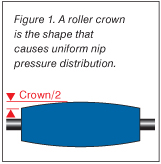
Many industrial manufacturers rely on crowned rollers. A crown is a shape or diameter profile necessary to compensate for deflection and obtain uniform nip pressure distribution (see Figure 1).
Compensating for Deflection
Roll crowning ensures accurate web alignment and counters the effects of deflection. In a simple nip system, roller deflection is one of the main reasons for nip variations across the width of the roll face. Deflection is evident in end-loaded rollers. The roll will deflect or bend away from the nip, which causes pinching at the ends as seen in Figure 2.
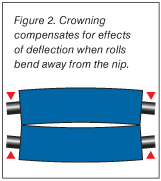
Roller deflection means there is bending due to its dimensions, material, and the load being applied to the roll in its particular application. Therefore, roll crowning is one common method of reducing nip variation caused by roller deflection.
Another benefit of crowning a roll is improved product quality. And more importantly, crowning helps the roll covering last longer, increases the rubber life, and helps reduce machine downtime.
Assuring Results
Specifying a crown on a roller must be done with precision. This is especially true when grinding or cutting an accurate crown. It is such a difficult process that if the shape/profile is compromised, it will cause more problems than not crowning at all.
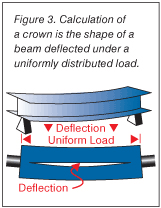
The amount of crown needed usually is very small and within a magnitude of a few mils (0.001 in.). The amount of crown (barrel shape) is calculated from beam deflection formulas. The shape of a crown is nominally the shape of a beam deflected under a uniformly distributed load as shown in Figure 3.
The latest computerized grinding machines, along with the basic beam principle, roller specifications, and the user's operating load requirements, are the factors leading to precision crowned rollers. In general terms, a program takes the deflection formula or tabulated values to produce the correct shape. There are a couple of commonly used crown angles for many converting operations and for heavily loaded rollers with great lengths or unique header designs.
Checking & Testing
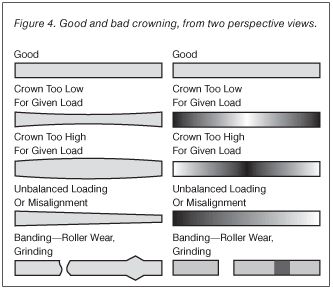
A number of methods are used to assure correct crowning prior to shipment (see Figure 4). They include measurement by a laser micrometer to check targeted crown shape and magnitude across the width of the roll. Another check is done to look at the nip profile with nip impression paper and other similar techniques.
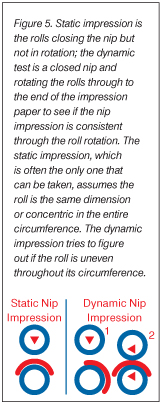
The static nip impression test is one of the easiest and safest methods that can be performed (see Figure 5). It can be used to interpret results from the actual impression taken at the nip. Additionally, a dynamic nip impression test is a tool used to crosscheck quality of the working crown.
There are other methods of checking nip impressions. One is using embossed foil, which is evaluated by reading the embossing elements flattened in the closed nip. This method is helpful when testing heated nip rolls. The embossed foil eliminates worrying about ink running, bleeding, or blotting that results in using carbon paper.
A popular form of crown evaluation is an electronic nip reader. This device converts the nip loading and variances into real time data. Its benefit is in quickly reading and adjusting roll alignment or loading at the startup or at maintenance shut down.
This electronic device has no real advantage, except speed, over a static or dynamic nip impression test in terms of crown adjustment. Why? Crown correction is done outside the production machine or more precisely at a grinding shop.
Results from testing confirm the following items:
- The need for a crown (on uncrowned rolls);
- Crown accuracy (for crowned rolls);
- Roll alignment quality;
- Actual nip width.
Nip Load Versus Crown
Roll crowning is the first aspect, but another very important factor must be noted in regard to the nip load versus crown. In Figure 2, there is an externally applied force at the ends of one of the rolls that actually provides the nip load. Therefore, the amount of deflection, and as a result the crown amount, is determined by the nominal nip load.
There is a load (x) that determines the required crown (y), and thus a given crown (y) matches only the value of load (x). Any other load than the match load above will not provide uniform nip loading across the width. Consequently the problem in a simple nip system is that the nip load cannot be changed without negatively affecting the uniformity of the nip.
This poses a big challenge when there are a number of different grades or products that must be run. Fortunately, there are solutions to this problem, and they consist of deflection compensation techniques.
These techniques include using a small roller on a large roller nip system, roller skewing, and using a specialty roller like a controlled crown roller. The end result is that these techniques are weak and provide only a limited range of adjustment. As a result, we advise crowning one of the rolls to the lightest load and using deflection techniques to achieve higher operating loads.
Ideally, crowns should be used in the design of rollers and equipment and not because of it. When the advantages of crowning rollers are carefully considered, the benefits add immeasurably to converting processes.
Matt Menges has been president of Menges Roller since 1984. He has experience in every aspect, from manufacturing to roll engineering, since his graduation from college. His troubleshooting for customers inside their plants includes after-market and OEM manufacturing. Special expertise is in core and end-use application engineering. Matt Menges can be reached at 847-487-8877. (Contact the company for the complete Crowned Roller Report at www.MengesRoller.com).
The views and opinions expressed in Technical Reports are those of the author(s), not those of the editors of PFFC. Please address comments to the author(s).
Applicable Converting Issues
- Web is not tracking properly and/or moves back and forth
This usually is caused by uneven nip pressure or a wider nip area in one area of the web. The larger nip area pulls the substrate at a differing rate than the smaller area during nip lead in or nip lead out, which causes the web to move back and forth.
- Excessive wrinkling or foldovers of the web or sheet
This is the same issue as above. An uneven nip pressure causes an unbalanced pull because of an unequal dwell time of the substrate in the nip. This wrinkling can be made worse by downstream pull rollers that actually pull the web as the uneven nip is holding the substrate, which creates wrinkles in the sheet.
- Uneven coating weight or laminating films are baggy in the center or the edges
Because the nip is uneven across the face, coatings are immediately lighter in the middle. This problem usually gets worse as operators add pressure to the ends of the rolls, which causes deflection or bowing of the rolls. In laminating, the low center causes poor laminating film penetration, which can be a cause of wrinkles pulled into the sheet as the deflection causes greater and greater nip pressure irregularities. “Laminating is an art form,” says a roller user. “The nip pressure can be perfect, but other factors like humidity can drive operators crazy.” The point is that laminating will not tolerate uneven nip values.
- Tracking or steering is the issue
Crowns can be used to align or steer. If you can picture a band saw, the blade runs between two large wheels with a steep crown. The blade stays perfectly centered on top of a steep crown. For example, steel mills utilize crowns to steer a difficult web of steel, which is stretched as tight as a piano wire through coil lines as long as a football field.
- I crowned my rollers and I still have problems
A crown is a tool in your tool box. Used correctly, it will solve problems. However, it will not rectify a poor design or bad machine alignment. For example, a paper machine roll 25 in. in diameter and 40 ft in length can only be designed to work with crowning as an absolute preconceived notion from the start. Paper machine engineers don't design their rollers to find out they have uneven nip pressures and then go back to the drawing board.




